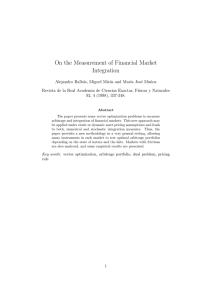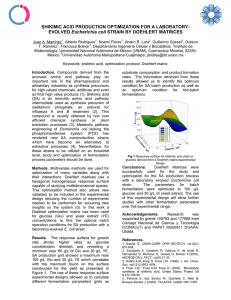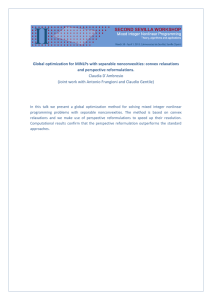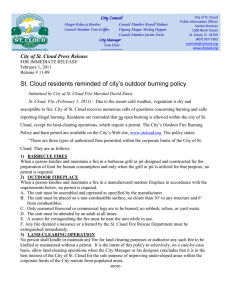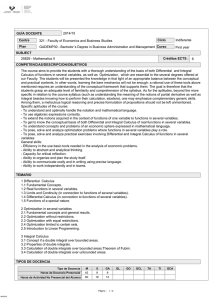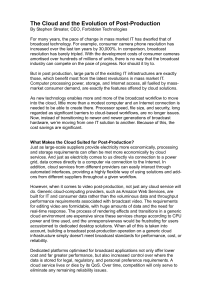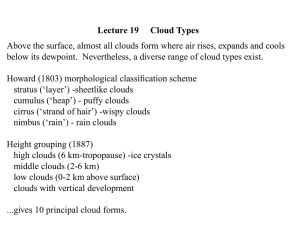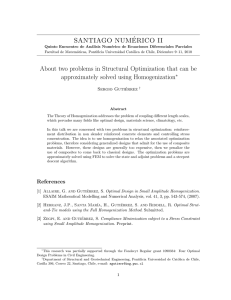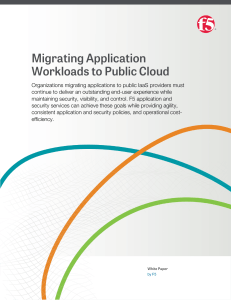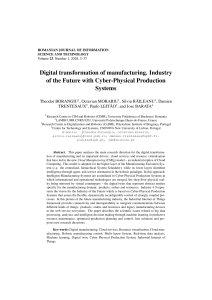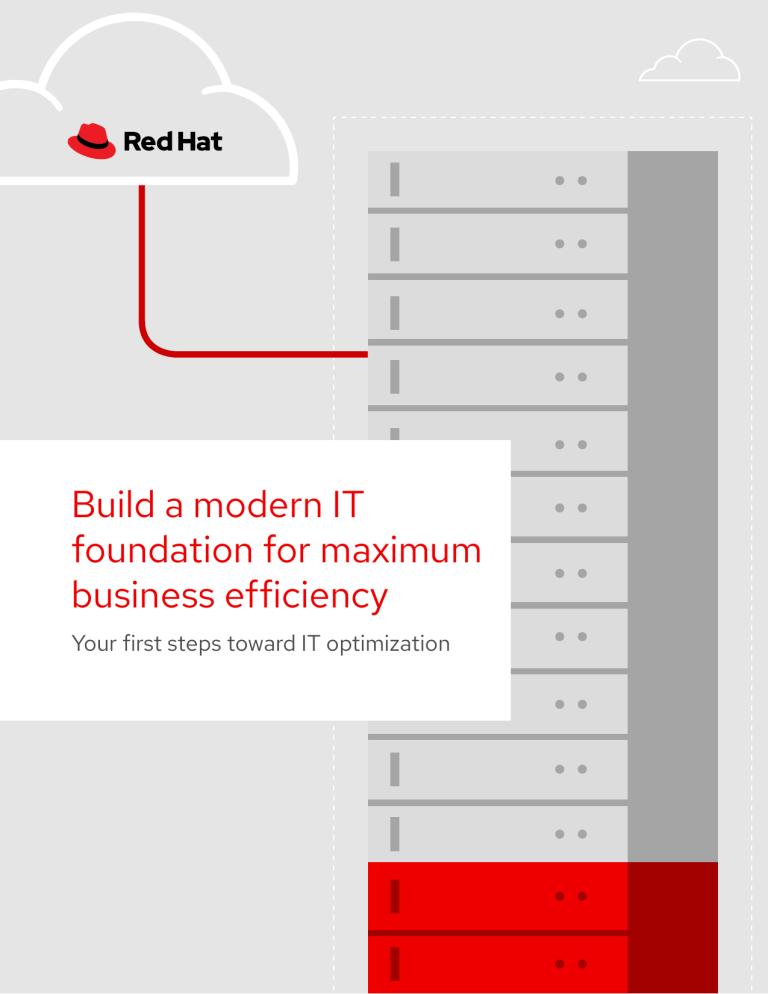
Build a modern IT foundation for maximum business efficiency Your first steps toward IT optimization Table of contents 03 Optimization—An efficient foundation for modern IT 08 Step 3: Optimize in the cloud 04 IT optimization defined 09 Step 4: Continue to migrate where it makes sense 05 Are you ready for IT optimization? 10 Checklist: Top security and compliance concerns 06 Step 1: Create consistency 11 Take the first step 07 Step 2: Start with software Build a modern IT foundation for maximum business efficiency 2 Optimization—An efficient foundation for modern IT Today’s IT transformation is all about finding smarter ways to do business. Leadership is looking for solutions that accelerate output to meet rapidly changing customer demands. However, many organizations struggle to deploy modern infrastructure due to the maintenance cost and management complexity of their existing systems. Studies show that IT spends 71% of its budget on maintenance.¹ The process of IT optimization helps you incrementally reclaim that budget. The challenge is knowing where to start. Cloud, hyperconverged solutions, as-a-service delivery models, and more all compete for priority, leading to decision paralysis that keeps organizations from reaching their full potential. It is time to make a choice. With an optimized IT foundation that supports automation and scales as you grow, you will implement what you want, when you want, without complex processes. By optimizing IT, you can focus your staff and budget on the projects that deliver deeper value to your customers. The demonstrated value of IT optimization: 20% 55% 63% 75% 20% cut in IT environment operating costs² 55% less staff time spent on workloads compared to non-paid Linux infrastructure3 63% less unplanned downtime compared to non-paid Linux infrastructure3 75% cut in change delivery time4 1 Futela, Shreya, and Disha Badlani, and Eric Stegman. “IT Key Metrics Data 2019: Executive Summary.” Gartner, December 17, 2018, www.gartner.com/en/ documents/3895271/it-key-metrics-data-2019-executive-summary. 2 Red Hat case study. “CTOS improves agility for faster business expansion with Red Hat,” November 2017, www.redhat.com/en/resources/ctos-case-study. 3 Marden, Matthew, et al. “The Business Value of Red Hat Solutions and Cost Relationship to Unpaid Alternatives,” IDC, July 2019, www.redhat.com/en/resources/ idc-business-value-red-hat-solutions-compared-to-unpaid. 4 Red Hat case study. “British Army speeds service delivery with Red Hat Ansible Tower,” December 2018, www.redhat.com/en/resources/british-army-case-study. Build a modern IT foundation for maximum business efficiency 3 IT optimization defined IT optimization is an incremental and methodical set of changes that moves your organization toward a standard infrastructure. This process becomes both a catalyst for change and a means to free up budget to invest in greater innovation. Optimization doesn’t happen all at once, which is good news for your organization. Through strategic optimization, you’ll gradually introduce your teams to new levels of agility while improving overall productivity and business performance. With optimized software, platforms, and processes, you achieve faster delivery of software and services to both internal and external customers. At its core, optimization is the foundation for IT modernization and long-term success. Three ways optimization boosts your innovative potential Digital transformation Standardization Simplified management • Incrementally frees up budget • P rovides a common, consistent framework • O ptimizes, secures, and scales infrastructure across hybrid cloud and multicloud deployments • P rovides a documented return on investment (ROI) and lower total cost of ownership (TCO) • S treamlines security and improves compliance • B uilds the foundation for innovation required to remain competitive • P romotes the automation that tames complexity and reduces errors • A llows for intelligent and systematic management of all elements of infrastructure across both modern and traditional IT environments Are you ready to get started? Build a modern IT foundation for maximum business efficiency 4 Are you ready for IT optimization? Are you unsure that IT optimization is what you need? If you identify with any of the common challenges, IT optimization is your answer. You are ready to optimize your infrastructure when you: • S truggle to deploy modern infrastructure due to the cost of maintaining your current one. • S truggle with inconsistent management between infrastructures and environments. • R ely on outdated and proprietary platforms that force one-off management and risk security exposure. • L ack the necessary configuration standards to reduce risk and downtime. • R equire significant training, support, and operational costs to maintain and use multiple architectures. • R un multiple operating environments across physical, virtual, and cloud systems. • L ack the standardization required to automate manual processes. You are ready for optimized efficiency and consistency when you: • S truggle to take on bigger projects because your systems take disproportionate amounts of time and energy to maintain. • F ind it challenging to maintain consistency across a hybrid environment. • N eed better self-service and automation to help minimize error-prone, manual tasks. • M anually manage the system life cycle from provisioning to configuring to patching hosts. • M anually enforce license usage to stay compliant with subscription agreements. • S pend a significant number of hours manually patching systems. You are ready for optimized processes and governance when you: • L ack a systematic process for creating, tracking, and reporting end-to-end consumption. • C an’t keep up with complex security policies, audit processes, and compliance with industry standards. • H ave difficulty managing system life cycles, patching, maintenance, and subscriptions across on-premise, virtualized, and cloud-based deployments. • R eact to breaches rather than proactively and prescriptively manage vulnerabilities. Build a modern IT foundation for maximum business efficiency 5 Step 1: Create consistency IT teams often spend a disproportionate amount of time, energy, and budget managing hybrid environments throughout development cycles. They create custom scripts to deploy and maintain multiple platforms and use proprietary solutions and manual processes. These inconsistent environments hinder growth and demand reactive maintenance. Additionally, supporting multiple platforms increases the need for training, support, and operational budget. The first step in IT optimization is to create a standard operating environment (SOE) across the entire organization. You will want to focus on choosing a modern solution that supports new technologies and practices, including hybrid and private cloud connectivity, cloud-native development, and containerization. By choosing a standard platform, you can: Eliminate error-prone manual tasks through automation and self-service. $ $ $ $ $ $ $ $ How much can you save per year?⁵ With a consistent infrastructure built on paid, open source technologies, the efficiencies stack up. According to IDC, the average annual benefits per 100 users include: IT staff productivity: $10,365 saved through efficiencies to automation, centralization of patching and updating, and ease of provisioning Risk mitigation: $4,200 saved by eliminating downtime Centrally manage the system life cycle, including provisioning, configuration, and patching. IT infrastructure cost reductions: Manage all license usage and stay compliant with subscription agreements. Significantly reduce the time it takes to install, upgrade, and patch software. $874 saved by optimizing licensing and training costs Business productivity: $1,756 saved Improve security and decrease shadow IT. by better addressing business opportunities 5 Marden, Matthew, et al. “The Business Value of Red Hat Solutions and Cost Relationship to Unpaid Alternatives,” IDC, July 2019, www.redhat.com/en/resources/idc-business-value-red-hat-solutions-compared-to-unpaid. Build a modern IT foundation for maximum business efficiency 6 Step 2: Start with software You cannot deliver transformation on traditional infrastructure. However, starting with new hardware is not only expensive, but also it might not yield the results you want. And if you migrate your existing operating environment to a new platform, you will recreate the same problems you already have. By modernizing your software first, you will gain greater efficiency while accelerating your potential to adopt cloud-native and container-based development practices for even greater agility. Opportunities for software modernization Operating system Management tools Select an operating system that not only builds a foundation for cloud agility and scalability, but also supports your existing development projects. Increase control with a single, centralized platform that provides proactive management of your entire infrastructure. $44,500 38% 20% average three-year TCO savings through standardization⁶ more efficient IT infrastructure teams⁷ reduced IT environment operating costs⁸ Development platform Legacy platform migration Move toward modernization with virtualized environments that support your current efforts, accelerating deployments and enabling cloud-native and containerized development practices. Eliminate expensive proprietary virtualization and open up an enterprise-ready pathway to elastic, scalable, and cost-efficient on-site cloud architectures built on open source technologies. 34% 21% 32% 63% reduction in time required to deliver new applications⁷ average productivity gain for development teams⁷ lower infrastructure costs⁷ less unplanned downtime⁷ Reduce IT deployment time from weeks to hours⁹ Ultimately, software modernization results in a 368% three-year return on investment (ROI).⁷ Once you’ve standardized on a single platform, you can start modernizing hardware and migrating to the cloud. 6 “Migrating from UNIX to Linux on an open-standards platform,” redhat.com, 2018, www.redhat.com/en/resources/ intel-unix-linux-open-standards-platform-partner-solution-overview. 8 Red Hat case study. “CTOS improves agility for faster business expansion with Red Hat,” November 2017, www.redhat.com/en/resources/ ctos-case-study. 7 Marden, Matthew, et al. “The Business Value of Red Hat Solutions and Cost Relationship to Unpaid Alternatives,” IDC, July 2019, www.redhat.com/en/ resources/idc-business-value-red-hat-solutions-compared-to-unpaid. 9 Red Hat case study. “Red Hat infrastructure migration solution,” 2019, www.redhat.com/en/resources/infrastructure-migration-solution-brief. Build a modern IT foundation for maximum business efficiency 7 Step 3: Optimize in the cloud As you start to standardize and optimize your infrastructure, you begin to experience the benefits, including ease of upgrades, updates, and improved security. You will position yourself for the next step—building a cloud-ready platform. Cloud computing has created a dynamic, powerful alternative to monolithic server purchases and impactful datacenter refreshes. Public cloud allows you to add compute, storage, networking, and services as needed and provides near-instant access to turnkey modern development environments. Private cloud solutions offer compelling benefits from improved security, increased flexibility, and the elimination of complicated server and application management on legacy platforms. By using the best solutions for your business in an optimized hybrid cloud environment, you can incrementally replace aging infrastructure without downtime to benefit from a flexible, stable, and efficient operating environment. You will also provide automation and self-service for users—an important consideration for developers who benefit from having on-demand IT resources to propel innovation for the business. 63% Tame virtualization sprawl with an open, hyperconverged environment In an effort to simplify and tame virtualization sprawl, many organizations go all-in on one public cloud, resulting in vendor lock-in. Alternately, they adopt high-level services that result in increasing costs. Or worse, they do nothing and continue maintaining costly legacy systems. Another approach, an open hyperconverged infrastructure (HCI) environment provides a mature software-defined datacenter stack, including a standard operating system, virtualization, and software-defined storage (SDS). This foundation for modernization simplifies management, increases operational efficiency, and provides built-in cloud elasticity that scales on demand. By replacing sprawling legacy virtualization systems with open HCI, you will build a foundation for upstream innovation, including containerized and cloud-native development, while greatly lowering acquisition and operational costs by using an open source subscription model. 3% of organizations 6 use two or more IT environments.10 The top two strategies for hybrid cloud are: 30% 21% Dynamic movement On-premise for existing, with new apps in the cloud 66% 6% of organizations 6 using hybrid cloud are in the planning or implementation stages. 75% By 2020, 75% of organizations will have deployed a multicloud or hybrid cloud model.11 10 Cloud Technology Research, May, 2018, Red Hat and Qualtrics. 11 Nag, Sid, and David Ackerman. “Market Insight: Making Lots of Money in the New World of Hybrid Cloud and Multicloud.” Gartner, Sept. 27, 2018, https://www.gartner.com/en/documents/3889017/market-insight-making-lots-of-money-in-the-new-world-of-. Build a modern IT foundation for maximum business efficiency 8 Step 4: Continue to migrate where it makes sense IT teams often stick with familiar tools, even when they stop providing the same level of innovation or value. In many cases, the current decision makers are the previous users of those same tools. Optimization is a continual process that challenges decision makers to keep looking toward new solutions that offer greater value to the organization. Where to look for migration opportunities in your organization Virtualization Shadow IT On-premise infrastructure Legacy virtualization tools result in both elevated risk and cost, with virtualization lock-in that prevents migration of applications to cloud-native and containerized environments. When business units resort to shadow IT, it can mean that internal IT is not delivering innovation quickly enough. Many organizations look to hyperconverged infrastructure (HCI) to simplify management and increase operational efficiency. However, proprietary HCI offerings are often more costly due to inflexibility than more modern open source options. Look for an open source virtualization solution that supports modern development practices, including cloud-native and containerized development. Build a modern IT foundation for maximum business efficiency Continued optimization and modernization in targeted areas of the business can eliminate shadow IT while providing teams with the tools they need to deliver innovative solutions. An open, hyperconverged solution can solve inflexibility issues while providing simplified management and a mature program stack in a secure and compliant platform. 9 Checklist: Top security and compliance concerns Security and compliance are not a step of their own in the optimization process. They remain a persistent funding priority, and you should address them regularly. Top 10 funding Your optimization priorities for 2018:12 solution needs to: Cloud infrastructure 48% Quickly secure systems and ensure compliance by regularly patching multiple systems at once. 46% Security 36% Automation Automatically assess both potential and active risks to your organization. 32% IT optimization 23% Storage utomate tasks such as A provisioning, patching, and content management, thereby freeing up your time for strategic projects. 22% Big data, analytics 18% Compliance 17% Integration 15% IT management 13% Containers 0% 10% 25% 20% 30% 40% 25% of customers surveyed named funding and budgets as a top-three challenge. 50% Provide in-depth analysis and details of risks affecting every system, along with prescriptive analytics and stepwise remediation guidelines. Accurately show how many and which systems in your environment are affected by security, configuration, or performance risks. Have the ability to automatically remediate known security vulnerabilities to reduce exposure. Provide rich reporting capabilities to keep stakeholders updated and to ease security compliance audits. Scan and remediate security controls in an automated way for ease of compliance to both regulatory and custom security policies. 12 “Red Hat Global Customer Tech Outlook 2018: Customers doing more with existing IT investments, expanding the role of cloud initiatives.” redhat.com, January 25, 2018, www.redhat.com/en/blog/red-hat-global-customer-tech-outlook-2018. Build a modern IT foundation for maximum business efficiency 10 Take the first step IT optimization is about balancing modernization and budget. You can take the first step toward platform modernization with a consistent foundation for the enterprise hybrid cloud—you will have what you need to optimize your virtualization environment, accelerate cloud-native development, improve security and compliance, and modernize your storage solution. With this first step, you will begin to free up budget so you can focus on innovation, carrying you forward on your pathway toward hybrid cloud success. Learn more about IT optimization with Red Hat at red.ht/OptimizeIT.
